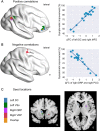Striatal Functional Connectivity Alterations After Two-Week Antidepressant Treatment Associated to Enduring Clinical Improvement in Major Depressive Disorder
- PMID: 31920745
- PMCID: PMC6915079
- DOI: 10.3389/fpsyt.2019.00884
Striatal Functional Connectivity Alterations After Two-Week Antidepressant Treatment Associated to Enduring Clinical Improvement in Major Depressive Disorder
Abstract
Background: Only less than 40% of patients with Major depressive disorder (MDD) can achieve remission after several weeks of initial antidepressant treatment. Predicting whether the prescribed treatment is effective in the following course may help clinicians modify the treatment regimen in time, and reduce the staggering burden for patients and society. However, there are not yet reliable markers based on neurobiological change after a treatment regimen steadily applied, for predicting clinical treatment outcome. The striatal circuits often exhibit abnormality for MDD patients, and are implicated in antidepressant treatments. Methods: Nineteen first-episode drug-naive MDD patients (nine females, mean age was 30 years old) were recruited to undergo clinical symptom assessment and resting state fMRI scanning at baseline, after 2 and 8 weeks of treatment with duloxetine. A seed-based analysis was used to obtain functional connectivity (FC) maps of six sub-regions of the stratum, then we explored the relationship of 2-week changes of striatal FC with clinical symptom improvement after 8-week duloxetine treatment. Results: The results revealed that 2-week FC changes of the striatal cognitive and affective subdivisions with the frontoparietal regions positively correlated with 8-week symptom improvement. We also found that early FC changes between the striatal motor subdivision and the motor-related cortical regions negatively correlated with later symptom improvement. Conclusions: These findings suggest that change of the FC of the cortical-striatal circuits at the early stage of treatment is critical for later remission of MDD. Furthermore, the association between the FC change and symptom improvement may have significant implication for clinical practice to regard neural changes as reference for evaluating how antidepressant treatment works.
Keywords: antidepressant; clinical improvement; major depressive disorder; prediction; striatum.
Copyright © 2019 An, Li, Wang, Su, Wang, Li, Zeng, Kong, Yan and Si.
Figures


References
-
- APA Diagnostic and statistical manual of mental disorders. 4th ed. Washington, DC: Author; (2000).
LinkOut - more resources
Full Text Sources

